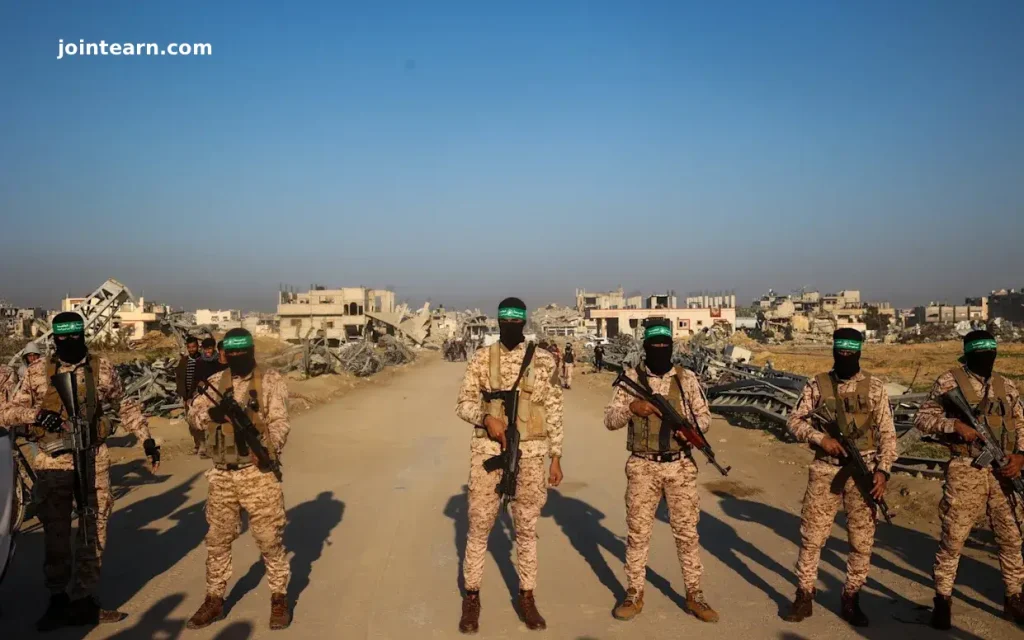
GAZA CITY, October 25 — 6:00 AM — Barely days after a fragile ceasefire began under Donald Trump’s Middle East peace plan, Hamas has moved rapidly to re-assert its authority across the Gaza Strip, seizing facilities, intimidating rivals, and rebuilding its vast underground tunnel network.
The swift resurgence has raised fears among international observers that the militant group is already consolidating power to make itself “impossible to dislodge,” despite Washington’s assurances that the peace deal will usher in a new era of stability for Gaza.
A Violent Return to Power
At the Gaza Community Mental Health Programme, staff who thought the fighting was finally over were shocked when armed Hamas militants stormed the clinic, forcing doctors and patients out. Witnesses said the gunmen seized the building and later moved in their own families, ending vital mental-health care for hundreds of residents.
Just days before, the group’s leadership had been in hiding — buried deep in tunnels to escape Israeli airstrikes. But as soon as IDF troops withdrew in accordance with phase one of Trump’s ceasefire plan, Hamas fighters flooded back into Gaza City and other key areas, re-establishing checkpoints and command posts.
The World Health Organization condemned the takeover, describing it as a breach of humanitarian principles and an assault on Gaza’s fragile recovery.
Brutal Crackdown and Reprisals
According to reports gathered by regional media and rights groups, reprisals, beatings, and mass public executions have become routine in the days since the ceasefire took hold. A spokesman for the Palestinian security forces in Ramallah compared the renewed repression to Islamic State-style tactics.
Security analysts say Hamas has rearmed, reorganized, and redeployed its forces at lightning speed. The group is now waging battles against Gaza’s powerful armed clans, including the Doghmush family, which has long resisted Hamas dominance.
In one widely circulated video, Hamas fighters executed several Doghmush captives in front of a crowd — a show of force that horrified outside observers but sent a clear message of control to Gaza’s population.
Despite losing air support from Israel, Hamas has outgunned rival clans with stockpiles of RPGs, drones, and automatic weapons, some allegedly captured from opposition fighters or repurposed from unexploded munitions.
Analysts: “Hamas Is Going Nowhere”
Dr. Kobi Michael, former head of the Palestinian desk at Israel’s Ministry of Strategic Affairs, told The Telegraph that Hamas is deliberately reshaping post-war Gaza to cement its presence permanently.
“Every day they are making progress,” Michael said. “Hamas has not changed its DNA. They have no intention of disarming or withdrawing from Gaza — whatever the Trump plan might dictate.”
U.S. Vice-President J.D. Vance and senior Trump administration officials visited Israel this week to reaffirm confidence in the ceasefire agreement. Yet experts fear Washington is underestimating Hamas’s resilience, noting that previous truces have failed to curb the group’s influence.
The Trump Plan and Regional Power Games
President Trump has warned that he will “obliterate Hamas” if the group refuses to disarm. But Israeli analysts suggest Hamas doubts the credibility of that threat.
“They believe Trump’s focus is on ending the war quickly,” Michael said, “not on enforcing disarmament or post-war governance.”
Under the U.S.-brokered framework, Turkey and Qatar have been given key oversight roles as “guardians” of the peace plan. Both nations are sympathetic to Muslim Brotherhood-inspired movements, and Israeli officials fear they may delay or dilute Hamas’s disarmament.
Intelligence sources suggest Hamas’s visible displays of control — from public parades to intimidation of dissenters — are part of a strategy to convince the world that its rule in Gaza is a political reality that cannot be reversed.
Repression Under the Banner of “Security”
According to Ahmed Fouad Alkhatib, a Gaza-born analyst and senior fellow at the Atlantic Council, Hamas has reopened its interrogation centers inside hospitals, summoning suspected opponents and silencing activists who criticized the group during wartime.
Telegram and other platforms now host daily videos showing alleged criminals or dissidents being beaten — sometimes with iron poles — in the name of restoring order.
“They are reminding civilians who’s in charge,” Alkhatib said. “Hamas is saying, ‘We’ve survived two years of war, and we’re still here. We won’t accept international forces or disarmament. You, the civilians, are our bargaining chips now.’”
Negotiations in Egypt Expose Regional Divides
Peace talks in Cairo are revealing deep divisions in the Arab world over Gaza’s future.
- Turkey and Qatar are reportedly pushing for Hamas to retain a role in governance.
- Saudi Arabia and the United Arab Emirates, by contrast, favor restoring authority to the Palestinian Authority (PA) under Fatah.
- Rumors suggest Egypt may allow Turkish and Qatari influence over Gaza’s proposed Board of Peace, alarming Israeli officials who refuse to accept Hamas participation.
Meanwhile, proposals for an international stabilization force — potentially including troops from Indonesia and Azerbaijan — have been met with skepticism in Israel, where analysts cite the ineffectiveness of the UN Unifil mission in Lebanon as a cautionary precedent.
Gaza’s Humanitarian Crisis Deepens
While political maneuvering continues, Gaza’s civilians remain trapped in devastation. With much of the Strip in ruins, hundreds of thousands live in tents amid food shortages and looming winter storms.
One displaced resident told reporters:
“We dreamed the ceasefire would bring peace and reconstruction, but we see Hamas back on the streets, armed and policing the roads. Gaza is in a dark cycle.”
Humanitarian agencies warn that reconstruction cannot begin until security and governance are clarified. Yet as long as Hamas maintains its grip — reinforced by fear and force — that day may remain distant.


Leave a Reply